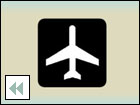|
Turbulence in the air
|
 |
December 19, 2001: 3:52 p.m. ET
The airline industry had its worst year ever -- but there are some hopeful signs.
By Staff Writer Chris Isidore
|
NEW YORK (CNN/Money) - Airlines are ending the worst year in the industry's history with some reason for hope -- even as red ink continues to flow.
Analysts now believe the industry, with the help of a federal government bailout, might survive without any of the bankruptcies feared in the wake of Sept. 11.
"I think that most of the major carriers should be able to avoid [bankruptcy] if things start to improve in the first half of the year," said Jim Corridore, Standard & Poor's airline equity analyst. "If a period of time goes by with no more terrorist events, I would say sometime in 2003 the industry could return to profitability."
There already are some encouraging signs. For one, travelers seem to be overcoming their post-Sept. 11 fear of flying. The Air Transport Association, the industry trade group, forecasts that nearly 40 million people will fly between Dec. 14 and Jan. 3. That's about 20 percent below year-ago levels, but slightly better than the forecast immediately following Sept. 11. And the near-empty planes of late September and early October should be nearly full by Dec. 21.
"The number of people flying is less horrific than it was shortly after the 11th," said John Heimlich, director of economic and market research for the trade group.
Profit Potential - But When?
The industry as a whole was on target to lose between $3 billion and $3.5 billion in 2001 even before the terrorist attacks. As a whole the industry lost $2.4 billion in the third quarter, even with federal payments of $2.4 billion during the period and only 20 days of operations following the attacks.
All the carriers are expected to lose even more money in the fourth quarter. Heimlich said industry losses this year are likely to approach $10 billion, not counting bailout money from the U.S. Government.
The federal bailout has given carriers direct aid of $3.8 billion so far, with another $1.2 billion still to come. Loan guarantees of another $10 billion are available, but so far a provision that could provide an equity stake for the federal government has stopped all the major carriers except America West Airlines (AWA: Research, Estimates) from applying for that assistance.
Still, there is a lot of bad news for the industry to fly through before it can hope to land profits once again.
Though fuel prices -- the industry's second-greatest expense after labor -- continue to fall, higher costs of insurance, interest and security measures probably have wiped out those savings, according to Heimlich. And any new oil shock caused by ongoing events in the Middle East would leave the airlines vulnerable to further losses.
Labor is another problem. UAL Corp., owner of United Airlines, has made the biggest push for concessions to date but has been unable to win any agreements.
The International Association of Machinists is arguing mechanics need a raise to match pay hikes granted to the company's other unions before the attacks or it won't even consider any concessions.
Analysts said that despite that hard-line approach they are hopeful that the current environment, which included the elimination of about 100,000 jobs in the weeks following the attacks, might let management roll back some of the earlier pay scales.
"I'm assuming changes are going to be made," said Ray Neidl, analyst with ABN Amro. "If they don't get changes, they can return to profitability at the up end of the cycle, but they will continue to lose money at the down end. That's a very dangerous way to operate."
The outlook for aircraft manufacturers may be even less optimistic than the airlines' merely turbulent forecasts. Leading aircraft maker Boeing Co. reiterated its guidance last Wednesday that deliveries are expected to fall to a range of 350 to 400 from the 522 deliveries expected this year. Further declines in deliveries are expected in 2003.
Click here for a look at airline stocks
Shortly after the attacks, Boeing said it would cut 20,000 to 30,000 jobs due to the drop in orders. European competitor Airbus Industrie announced its only layoff of about 500 employees Monday. Corridore said he doesn't see airlines making any significant additions to their thinned-down fleets for at least four to five years.
"They're looking to delay every possible delivery they can," he said. "They're looking to short-term survival, not long-term competitiveness that comes with new planes." 
|
|
|
|
|
|

|

